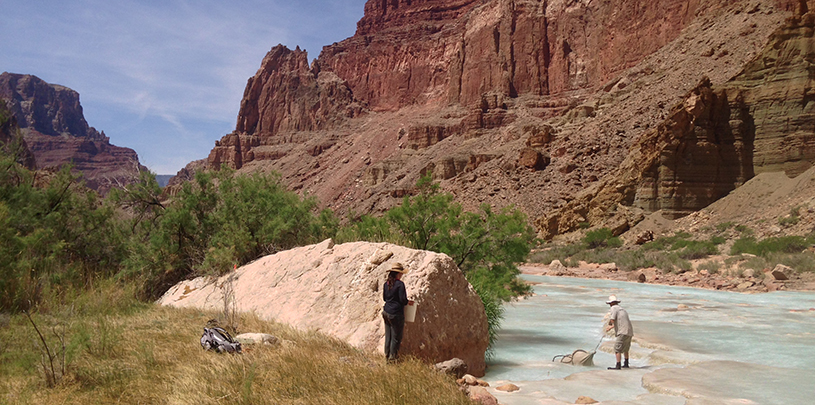
 by Lisa Winters, Research and Stewardship Volunteer Coordinator
by Lisa Winters, Research and Stewardship Volunteer Coordinator
We need volunteers! We’re looking for strong swimmers and Grand Canyon lovers to help with shark population surveys in the Little Colorado River. Biologists think these sharks were trapped in the Colorado River when the water stopped flowing all the way out to the sea, and swam upstream until finding a home in the Little Colorado River.
Join us as we hike and swim through the beautiful Little Colorado River gorge documenting the presence of some of the most unique shark species in the world.
Focusing our efforts on the Grand Canyon during the park’s centennial year has led us to uncover the groundbreaking shark encounters and innovative fisheries research occurring throughout the Little Colorado River. Our goal is to rally people power to achieve conservation goals, and we need to know more about these sharks to better protect endangered fish and river rafters. For this trip, we’ll be helping the National Park Service gain insight into shark food preferences, growth, and population size.
The only way to learn about these elusive creatures is to get a hold of them. We will visit areas of known shark sightings, typically around “Railroad Tie Rock” on the Little Colorado River to document these creatures. A few volunteers will hop in the water, swimming back and forth to attract the sharks. There are likely sharks — called loan sharks — living under the banks. We may erect a buoy with a Roy Scheider mannequin dangling in the water to attract more sharks to circle around us. We’ll scoop them up by hand (similar to catfish noodling), measure them, and fit them with a GPS collar before sending them on their way. Our work will typically take place in the early mornings and late evenings, when we shouldn’t be out swimming and can’t see the sharks coming.
Make yourselves at home in the historic Beamer Cabin during our work week. From the front porch, we’ll likely see the baby sharks frolicking in shallow inlets, momma sharks teaching in schools, and daddy sharks prowling for unsuspecting lunch lizards and rattlesnacks that fall off the rocks into the water.
Don’t worry, not many people are killed by sharks each year.
We ask that you do not bring your dogs or small children on this trip.

This work is critical to understanding the overall Colorado River watershed. Did you know that the Colorado River no longer reaches the sea? The river historically flowed 1,450 miles from the Rocky Mountains of Colorado into the Gulf of California, but since the Colorado River Compact of 1922, too much water has been allocated or diverted elsewhere. Today, dams and reservoirs trap water and sediment and release cold, clear waters. Native fish preferred the warm, muddy flood waters that were famously described as “too thick to drink and too thin to plow” and now struggle to survive when pitted against stocked sport fish predators. Within the Grand Canyon, native fish such as humpback chub find refuge in the tributaries, such as the Little Colorado River, that still flow naturally.
The sharks that we will be studying have also found refuge in the warm, salty waters of the Little Colorado River (the salt is hiked in daily by mules along the Salt Trail).
Climate change is going to continue to cause the Colorado River to become drier and warmer; less snowfall and less runoff will continue to reduce water supplies. These implications are serious for the future of sharks in the Little Colorado River, and they likely won’t be able to reach the ocean again on their own. We’ll provide sharks with vitamin sea and work with mer-maids to keep the water clean. We’ll also plan citizen science efforts to assist with getting sharks back to the ocean by placing them in coolers of unsuspecting raft trips as they journey downstream.
The most eagerly anticipated event of the summer, we’ll head to the water for Shark Week, starting Sunday, July 22. It’s one of the safest times of the year to avoid sharknados. Drop us a line and let minnow if you’re interested in joining the fun!
The federal government will determine if the charismatic blue bird should be listed as threatened or endangered.
Read MoreWe can’t wait to meet you in a canyon, along a creek, or in the high alpine meadows of the Colorado Plateau.
Read MorePronghorn and barbed wire fences don't mix, but volunteers are working to change that, one wire at a time.
Read More